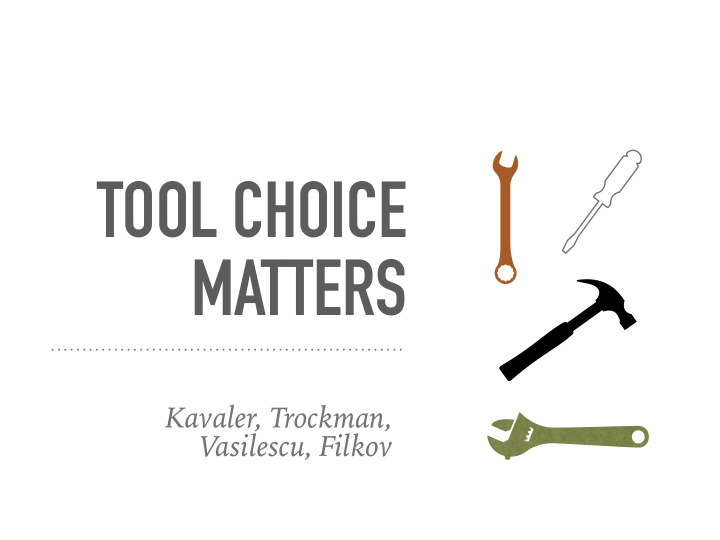



TOOL CHOICE MATTERS Kavaler, Trockman, Vasilescu, Filkov
SOFTWARE DEVELOPMENT KEEPS CHANGING ➤ Waterfall ➤ OOP Alexa, Good Morning. ➤ flexible o ff the shelf - sets thermostat to 69F ➤ modular - turn on lights - play “Thank u, next” ➤ collaborative ➤ agile ➤ platform independence ➤ containers ➤ automation, independence ➤ DevOps, CI, CD time
SOFTWARE DEVELOPMENT KEEPS CHANGING ➤ Waterfall ➤ OOP Alexa, Good Morning. ➤ flexible o ff the shelf - sets thermostat to 69F ➤ modular - turn on lights - play “Thank u, next” ➤ collaborative ➤ agile ➤ platform independence Relies on Tools More and more ➤ containers ➤ automation, independence ➤ DevOps, CI, CD time
� � � � � � � � � � � � � NEW TECH INCREASES PRODUCTIVITY AND PREDICTABILITY Relative productivity Estimation error Precedented Component- COTS Very-high-level Agents, agility, based languages aspects, autonomy Unprecedented A B C D Time and domain understanding From Boehm and Valerdi, 2008
I GOT TOOLS FOR THIS, I GOT TOOLS FOR THAT ➤ Tools available for many tasks ➤ QA: linters, package managers, coverage, testing, deployment COVERALLS
I GOT MULTIPLE TOOLS FOR THIS ➤ Many tools available for the same task ➤ E.g., dependency managers ➤ Projects adopt tools with features needed, presumably
WHICH ONES? ➤ But how are the tools chosen? ➤ What discussions precede the choices? ➤ Are any benefits seen/goals achieved after tool adoption?
PROJECTS USE MULTIPLE TOOLS 50000 37500 Number of projects 25000 12500 0 1 2 3 4 5 6 7 8 9 10+ Number of tools
PROJECTS SWITCH BETWEEN TOOLS ➤ Sometimes projects switch from one tools to another in the same task class ➤ Why do they switch? Is there a benefit?
WE LOOKED AT DISCUSSIONS ➤ We expected to find at least some discussions of the choices ‘ish clipart-library.com
RESEARCH QUESTIONS ➤ RQ1: How often do projects change between tools within the same task class? ➤ RQ2: Are there measurable changes, in terms of monthly churn, pull requests, number of contributors, and issues, associated with adopting a tool? Are different tools within an equivalence class associated with different outcomes? ➤ RQ3: Are certain tool adoption sequences more associated with changes in our outcomes of interest than others?
STUDY DESIGN ➤ Research methodology ➤ Software Repository mining ➤ Quasi-experiments, modeling, hypothesis testing ➤ Case studies for triangulation, theory building ➤ Focus: 3 task classes (linters, dependency managers, code coverage) ➤ Data: 54,440 projects, 38,948 tool adoptions
RQ1: TOOL SWITCHING ALLUVIAL DIAGRAMS 1 2 3 Dependency Manager 25000 800 20000 600 Tool 15000 400 bithound 200 david 10000 gemnasium 0 5000 1 2 3 0 1 2 3
RQ1: TOOL SWITCHING ALLUVIAL DIAGRAMS 1 2 3 Dependency Manager 25000 800 20000 600 Tool 15000 400 bithound 200 david 10000 gemnasium 0 5000 1 2 3 0 1 2 3 Most projects choose one tool within a task class and stick with it. When projects adopt additional tools within the same task class, they go with the most popular choice.
RQ2: EFFECTIVENESS BEFORE AND AFTER ADOPTION Effectiveness variables: churn, #pull requests, #unique authors, #issues
INTERRUPTED TIME SERIES: REGRESSION DISCONTINUITY ɣ β β + δ time : 1 2 3 … … … 100 101 102 … … … 200 time after intervention : 0 0 0 … … … 1 2 3 … … … 100 intervention : 0 0 0 … … … 1 1 1 … … … 1 y i = α + β· time i + ɣ· intervention i + δ· time_after_intervention i + ε i
SLOPE INCREASES OR DECREASES, AND DISCONTINUITY
SOME RESULTS
SOME RESULTS Control Variables
RQ3: ON ADOPTION ORDER
RQ3: SOME RESULTS
CONCLUSION AND FUTURE ➤ Tool choice matters but it is not discussed much ➤ Projects can benefit from adopting the right tool ➤ The order in which tools are adopted matters ➤ Future goal: bespoke tool pipelines, depending on project context
THANKS! ➤ NSF ➤ DECAL @ UCD ➤ Strudel @ CMU
Recommend
More recommend